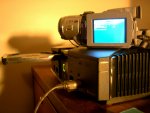Xebian Installed
 Today was devoted to installing Xebian, a flavour of Debian tailored
specifically to Xbox. After installation, it is 100% compatible with
Debian's pool of software, but has a slightly different bootup process,
as well as a kernel to be used specifically with this hardware. It is
now running fairly well, with video output to a video camera.
Today was devoted to installing Xebian, a flavour of Debian tailored
specifically to Xbox. After installation, it is 100% compatible with
Debian's pool of software, but has a slightly different bootup process,
as well as a kernel to be used specifically with this hardware. It is
now running fairly well, with video output to a video camera.
The first task to install a full Linux system was to overwrite the Flash with one that can boot Linux. This ROM, called Cromwell, was put together to be able to boot Linux. The author did not release the source code publically due to concerns that it could be used to do things considered illegal. To overwrite the normal Flash, two tiny connections that were deliberately left out by Microsoft, namely the traces the write pins, had to be filled in on the motherboard. Here is one of them next to a pin head:
![[xbox/20041113-2]](http://pat.suwalski.net/log/xbox/20041113-2.jpg)
That was a fairly easy task, and the chip flashed flawlessly using the tiny Linux install from yesterday. Next, the hard drive was replaced with one that is expendable. Finally, a CD with Xebian was burned, and a boot attempted. This is where the troubles started. The CD drive was having troubles reading writable media, since writable optical discs tend to be of lesser quality than commercially pressed discs. After four hours of trying various discs burned at various speeds, a Google search revealed that many Xbox optical drive lasers are not set powerfully enough to read writable discs. It was suggested that the laser should be "tuned" to be more powerful. As hinted, right next to the laser diode there was a potentiometer that could be set to lower resistance. It was rotated from approximately 1250Ω to approximately 1050Ω. This setting worked, Xebian installed:
![[xbox/20041113-3]](http://pat.suwalski.net/log/xbox/20041113-3.jpg)
There are still issues to work out. The biggest one is that the system does not want to boot directly from the hard drive. Instead, the Xebian developers provide a CD that is simply a bootloader to the installed system. There is confusion because documentation indicates the Cromwell Flash should be able to boot directly from the hard drive. More research is required here.
While the system was installing, I looked into the complexity of creating a VGA converter to output better video. Apparently, with the signals coming out of an Xbox designed to work with Composite, S-Video, and HDTV, there are enough signals to drive most VGA monitors with a straight-through connection. If the touch-screen LCD I purchase for this unit does not work in this mode, there is a very simple circuit that can be built between the Xbox and the monitor that transforms the synchronization signals into pure VGA.
All in all, this weekend made for good progress.
